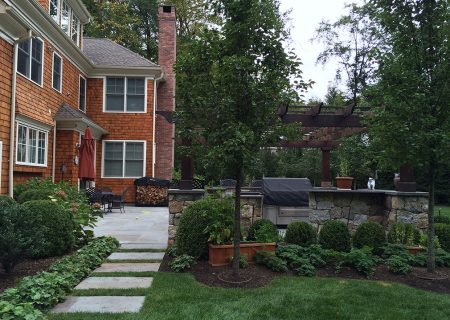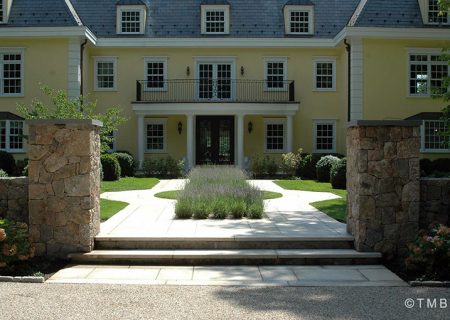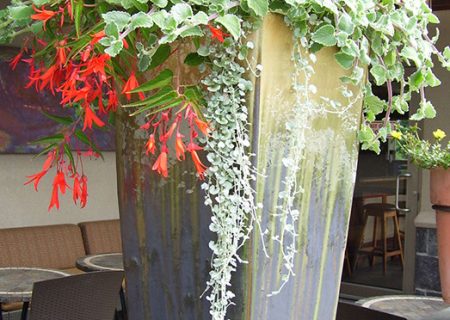BOXWOOD INTRODUCTION
Boxwood is one of the most useful and enchanting plants available to
gardeners and landscape designers. Few other plant varieties offer the
gardener or landscape designer with a foil from which to express hers
or his design skills.
Whether used as an accent, a hedge or in a staccato, rhythmically
marching along a guided path, boxwood is also a relatively pest free
plant if but a few cultural requirements are followed.
HOW TO USE BOXWOOD IN A DESIGN
Boxwood is a substantive plant that carries visual weight or mass
throughout the four seasons. This visual weight can be used to anchor
or accent the corner of a building, to frame an entry or to establish
gesture and tempo in the landscape. As a hedge, boxwood can be used
to create mystery or intrigue, a tease if you will, by dividing or partially
concealing adjacent spaces. Classically, boxwood is most associated
with parterre gardens or knot gardens and topiary. Here the strong
structural form of boxwood helps to visually hold up loose, playful
perennial and annual combinations.
Scaling the weight of boxwood to any of the above conceptual
arrangements requires feel and forethought. For example, primary
architectural mass or volume can be amplified into the landscape by
carefully juxtaposing boxwood with the most outward architectural
forms and details thereby creating transcendent spatial experience.
Using boxwood to create gesture in the landscape can exert a profound
and powerful influence on the circulation experience by controlling the
hierarchy of movement to views or focal points.
Gesture, a non-verbal form of communication, also creates a sense of
anticipation as in the still form of the human body in motion…about to
fall…or jump…or throw a disc. The anticipated motion can be used to
steer one’s gaze…or to literally steer one’s directional choice within a
garden. Here a playful grouping of boxwood can be arranged in a way
that simulates the dissipation or expansion (glissando) of energy.
Dissipation may ask one to slow down (largo) or to stop momentarily.
The expansion of energy may on the other hand cause one to begin to
move more quickly (presto) through the landscape, as if being pulled
along by ever more invisible hands.
Rhythm is gesture’s accomplice; here the spatial orientation of
boxwood, whether in staccato along a path or in Legato, create either a
marching tempo or tempo rubato – rhythmic freedom. The pace of
one’s gait, the movement of one’s eyes into the landscape and the beat
of their heart can quite literally be influenced by the thoughtful
placement of boxwood. It should be noted that the size of the
boxwood, scaled either to the architecture or adjacent to circulation,
will determine how effective any of the above techniques may be. For
example, boxwood sized at 5’ tall by 5’ wide along a garden path may
well impart an intentional imposing feel if set in a staccato arrangement
close to a path. On the other hand, this arrangement of boxwood can
be used to tether garden nodes thereby creating a feeling of theme.
USING BOXWOOD WITH OTHER PLANTS
Boxwood’s small leaf texture permit many opportunities to create
contrast with large leaved plants. Annabelle Hydrangea and Invincible
Spirit Hydrangea, for examples, both have large dull green leaves that
contrast very well with boxwood’s small shiny leaves. This type of leaf
contrast can be used effectively in distant portions of the garden. Saint
John’s Wort – Hypericum – create a subtle contrast that is ideally suited
to those areas of the garden that are viewed from closeup. Either
technique can be interchanged and the overall emphasis here is to
consider incorporating playful textural arrangements.
Boxwood also work very well with ornamental grass and a host of
perennials. In particular, varieties of Dwarf Fountain Grass
(Pennisetum) and Feather Reed Grass (Calamagrostis) offer a very
complex palette that extends into the winter months. Mediterranean
Perennials like Catmint, Lavender, Lamb’s Ears and Russian Sage
contain silvery foliage that contrast very well with boxwood. These
perennials also produce flowers that are in the deep blue to light blue
and purple range.
BOXWOOD INSECT AND DISEASES
Boxwood are affected in particular by Boxwood Leaf minor in addition
to Boxwood Blight…which seem to affect Common Boxwood more so
than other varieties.
Boxwood Leaf Minor can be controlled with Merit insecticide. Merit is a
systemic insecticide that is applied to the root zone. This product is
available as a 75% wettable powder, as a granule or as a concentrate.
Sevin can be used to help prevent an existing population of leaf minor
from spreading to new leaves.






